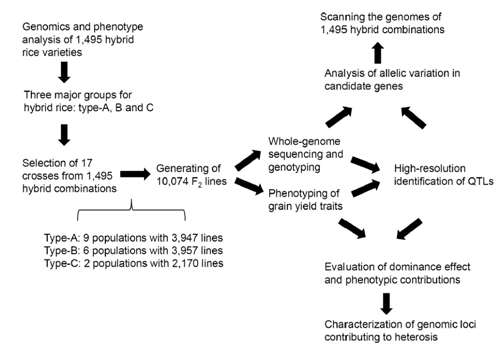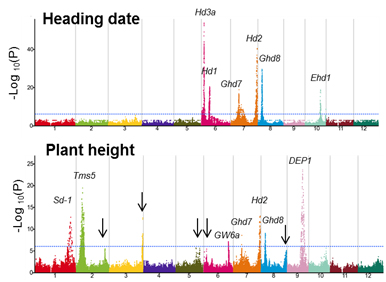SIPPE Researchers Make New Progress in Understanding Genetic Basis of Heterosis in Rice
On Sep 8, 2016 (Beijing time), Nature online published a research paper entitled “Genomic architecture of heterosis for yield traits in rice” from Prof. Bin Han’s group and Prof. Xuehui Huang’s group of Institute of Plant Physiology and Ecology (SIPPE), Shanghai Institutes for Biological Sciences, Chinese Academy of Sciences, with the cooperation from Prof. Shihua Yang’s group of China National Rice Research Institute.
Improvement of grain yield is an on-going effort in crop breeding to meet the demand of global food security. Exploiting the heterosis phenomenon in hybrid crop breeding is one of the most efficient ways to increase grain yield in many crops including rice, maize and sorghum. However, the genetic cause of heterosis in crop has long been a puzzle despite that the heterotic phenomenon has been discovered for more than a century and various genetic models have been suggested to explain it.
This work report large-scale genomic mapping for yield related traits and evaluation of the heterotic effects by analyzing over 10,000 rice lines produced from 17 elite rice lines. The large data of genomics and phenomics from the well-designed populations enabled us, for the first time, to identify the genetic contributors comprehensively and find out the exact causes of heterosis. They find that modern rice varieties can be classified into three major types, reflecting the major breeding systems. Within each group a few genomic regions and gene alleles from female parents linked to heterosis effects for improved yields were identified, but these loci varied across the three groups. The key heterosis-related genes often controlled several yield-related components simultaneously, severing as the major contributors of heterosis. For the individual yield components, the heterozygous state of the heterosis-related genes generally acted through the way of dominance complementation. Taking all the components into account, the hybrids with yield heterosis resulted from an optimal combination of multiple yield-related components, meaning better performance of overall yield in crop productions. These results inform on the genomic architecture of heterosis for yield traits in rice, which will be useful information for crop improvement programmes.
This project is financially supported by Chinese Academy of Sciences (XDA08020101) and the National Natural Science Foundation of China.
AUTHOR CONTACT:
Bin Han
National Center for Gene Research
Chinese Academy of Sciences Center for Excellence of Molecular Plant Sciences
Shanghai Institute of Plant Physiology and Ecology
Shanghai Institutes for Biological Sciences
Chinese Academy of Sciences
500 Caobao Road, Shanghai, 200033, China
Tel: +86-21-64845260
Fax: : +86-21-64825775
E-mail:
bhan@ncgr.ac.cnFigure 1. The experimental design and analysis procedure in this study.
Fig. 2. Large-scale sequencing, genotyping and genetic mapping in 10,074 F2 lines.

